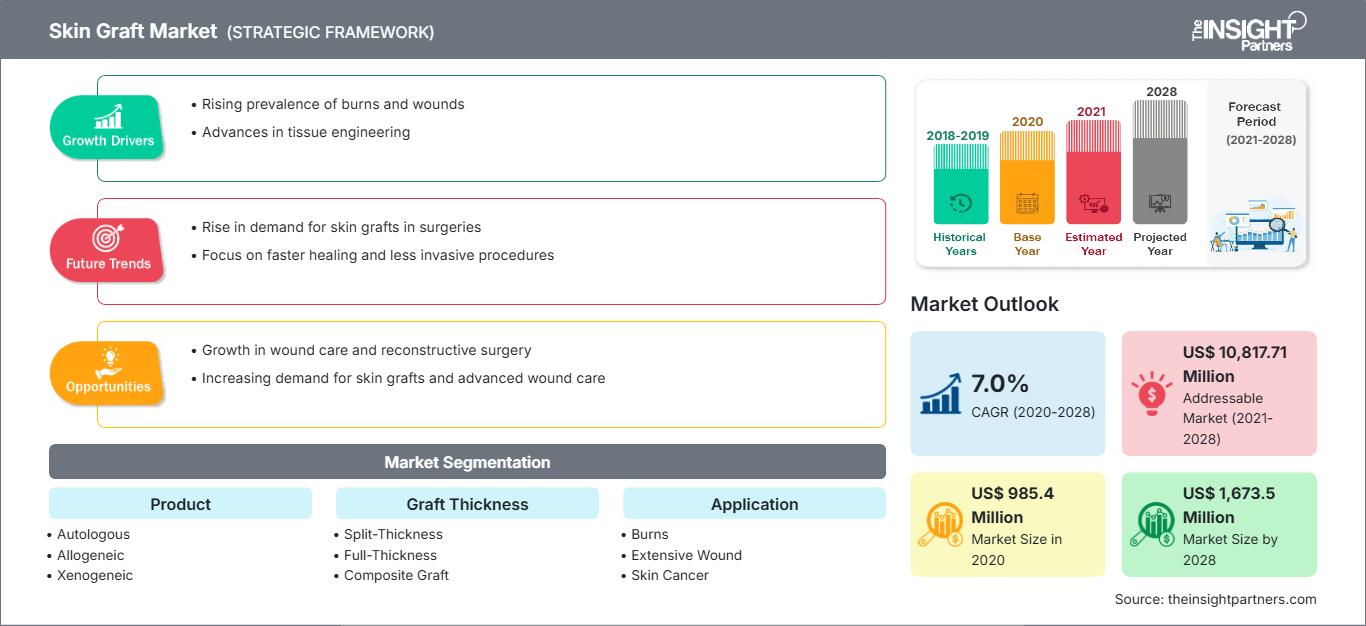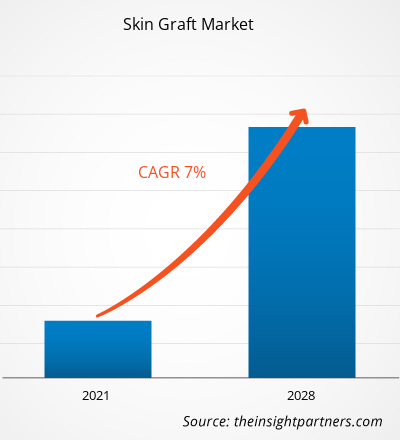El mercado de injertos de piel se valoró en 985,4 millones de dólares estadounidenses en 2020 y se prevé que alcance los 1.673,5 millones de dólares estadounidenses en 2028; se espera que crezca a una tasa de crecimiento anual compuesta (TCAC) del 7,0% entre 2021 y 2028.
El injerto de piel es una cirugía que consiste en el trasplante de piel mediante diversos tipos de injertos. Los injertos de piel también se utilizan para tratar heridas extensas, traumatismos y quemaduras. En el procedimiento de injerto de piel, se extrae un pequeño parche de piel de una parte del cuerpo del paciente y se implanta o trasplanta a la zona afectada mediante cirugía. El parche de piel se implanta en la zona lesionada o quemada.
El mercado de injertos de piel se segmenta según el producto, el grosor del injerto, la aplicación, el equipo, los usuarios finales y la región. Por regiones, el mercado se divide en Norteamérica, Europa, Asia Pacífico, Oriente Medio y África, y Sudamérica y Centroamérica. El informe ofrece información y un análisis exhaustivo del mercado de injertos de piel, haciendo hincapié en diversos parámetros, como las tendencias del mercado, los avances tecnológicos, la dinámica del mercado y el análisis del panorama competitivo de los principales actores del mercado a nivel mundial. También incluye el impacto de la pandemia de COVID-19 en el mercado en todas las regiones. Debido al brote de COVID-19, varios hospitales se dedicaron al tratamiento de las personas infectadas. Además, dado que diversos centros de atención de heridas operan dentro de los hospitales, la mayoría de los pacientes no pudieron recibir tratamiento para el cuidado de sus heridas. Aproximadamente 1 de cada 4 pacientes pudo recibir dicho tratamiento, y se estima que cerca de 6.7 millones de personas en Estados Unidos están en lista de espera. Los investigadores evaluaron la estabilidad del SARS-CoV-2 y del virus de la influenza A (IAV), mezclados con medio de cultivo o moco de las vías respiratorias superiores, en la piel humana, así como la eficacia de la desinfección dérmica con etanol al 80 % (p/p) contra el SARS-CoV-2 y el IAV. Para evitar infectar a voluntarios sanos, los investigadores realizaron experimentos de laboratorio utilizando piel de cadáver que, de otro modo, se habría utilizado para injertos de piel. El brote de COVID-19 ha impactado negativamente el mercado de injertos de piel al afectar la calidad de la atención.
Obtendrá personalización gratuita de cualquier informe, incluyendo partes de este informe, análisis a nivel de país y paquetes de datos de Excel. Además, podrá aprovechar excelentes ofertas y descuentos para empresas emergentes y universidades.
Mercado de injertos de piel: Perspectivas estratégicas

-
Obtenga las principales tendencias clave del mercado que se describen en este informe.Esta muestra GRATUITA incluirá análisis de datos, que abarcarán desde tendencias de mercado hasta estimaciones y pronósticos.
Perspectivas del mercado
Aumento de la prevalencia del cáncer de piel y la diabetes
Los injertos de piel son el tratamiento de elección tras la cirugía de cáncer de piel. Generalmente, se recomienda la radioterapia posoperatoria local (PORT) para asegurar el cierre del lecho quirúrgico creado durante la radioterapia. Según Cancer Research UK, en el Reino Unido se registran aproximadamente 15 400 nuevos casos de melanoma cada año, lo que equivale a 42 casos nuevos al día. Se prevé que la incidencia de melanoma aumente un 7 % en el Reino Unido entre 2014 y 2035, hasta alcanzar los 32 casos por cada 100 000 habitantes en 2035. Asimismo, según las estadísticas recientes publicadas por la Agencia Internacional para la Investigación del Cáncer (IARC), en 2020 se registraron 19,3 millones de nuevos casos de cáncer, excluyendo 18,1 millones de cánceres de piel no melanoma. Por lo tanto, es probable que el aumento de la prevalencia del cáncer de piel contribuya a la necesidad de injertos de piel en el futuro.
La diabetes es una de las afecciones más comunes en todo el mundo. Según la novena edición del Atlas de la Diabetes de la Federación Internacional de Diabetes (IDF) de 2019, aproximadamente 463 millones de adultos vivían con diabetes en todo el mundo. Se estima que la prevalencia alcanzará los 700 millones para 2045, lo que representa casi el 79 % de los adultos con diabetes en países de ingresos bajos y medios. Dentro de la prevalencia de la diabetes, la proporción de diabetes tipo 2 está aumentando a un ritmo mucho más acelerado. Según la IDF, 374 millones de personas corren el riesgo de desarrollar diabetes tipo 2 en el futuro próximo. En los pacientes diabéticos, la cicatrización de las heridas se prolonga, lo que aumenta el riesgo de infecciones cutáneas si no se curan en un plazo determinado. Aproximadamente el 25 % de los pacientes diabéticos tienen probabilidades de desarrollar úlceras en los pies al menos una vez en la vida, las cuales suelen requerir cuidados especializados. Por lo tanto, existe una creciente demanda de injertos de piel para tratar o cubrir las úlceras del pie diabético, eliminando así las posibilidades de contraer infecciones cutáneas. De este modo, se espera que la alta prevalencia del cáncer de piel y la diabetes impulse el mercado de injertos de piel en un futuro próximo.
Información basada en el producto
Según su tipo, el mercado de injertos de piel se segmenta en autólogos, alogénicos, xenogénicos, protésicos e isogénicos. El segmento autólogo representó la mayor cuota de mercado global de productos intermedios farmacéuticos en 2020, y se prevé que este segmento experimente el mayor crecimiento durante el período 2021-2028. El crecimiento del mercado de injertos autólogos se debe a su amplio uso para el tratamiento de quemaduras y heridas abiertas.
Información basada en aplicaciones
Según su aplicación, el mercado de injertos de piel se segmenta en quemaduras, heridas extensas, cáncer de piel y otras aplicaciones. El segmento de quemaduras representó la mayor cuota de mercado en 2020 y se estima que registrará la mayor tasa de crecimiento anual compuesto (CAGR) durante el período de pronóstico. Las empresas suelen adoptar estrategias inorgánicas, como alianzas, fusiones y adquisiciones, para satisfacer la demanda cambiante de los clientes y mantener su presencia de marca a nivel mundial. Los participantes del mercado de injertos de piel también adoptan estrategias orgánicas, como el lanzamiento de productos y la expansión, para ampliar su alcance y cartera de productos a nivel mundial, así como para satisfacer la creciente demanda.
Perspectivas regionales del mercado de injertos de piel
Los analistas de The Insight Partners han explicado en detalle las tendencias regionales y los factores que influyen en el mercado de injertos de piel durante el período de previsión. Esta sección también analiza los segmentos del mercado de injertos de piel y su distribución geográfica en Norteamérica, Europa, Asia Pacífico, Oriente Medio y África, y Sudamérica y Centroamérica.
Alcance del informe de mercado de injertos de piel
| Atributo del informe | Detalles |
|---|---|
| Tamaño del mercado en 2020 | 985,4 millones de dólares estadounidenses |
| Tamaño del mercado para 2028 | 1.673,5 millones de dólares estadounidenses |
| Tasa de crecimiento anual compuesto global (2020 - 2028) | 7,0% |
| Datos históricos | 2018-2019 |
| período de previsión | 2021-2028 |
| Segmentos cubiertos |
Por producto
|
| Regiones y países cubiertos |
América del norte
|
| Líderes del mercado y perfiles de empresas clave |
|
Densidad de los participantes en el mercado de injertos de piel: comprensión de su impacto en la dinámica empresarial
El mercado de injertos de piel está creciendo rápidamente, impulsado por la creciente demanda de los usuarios finales debido a factores como la evolución de las preferencias de los consumidores, los avances tecnológicos y una mayor conciencia de los beneficios del producto. A medida que aumenta la demanda, las empresas amplían su oferta, innovan para satisfacer las necesidades de los consumidores y aprovechan las nuevas tendencias, lo que impulsa aún más el crecimiento del mercado.

- Obtenga una visión general de los principales actores del mercado de injertos de piel.
Por producto
- Autólogo
- Alogénico
- Xenogénico
- Protésico
- isogénico
Por grosor del injerto
- espesor dividido
- Espesor completo
- Injerto compuesto
Mediante solicitud
- Quemaduras
- Herida extensa
- Cáncer de piel
- Otras aplicaciones
Por equipo
- Dermatoma
- Instrumentos quirúrgicos generales
- Consumibles
- Otros mercados
Por usuarios finales
- hospitales
- Centros quirúrgicos ambulatorios
- Clínicas de Dermatología
Por geografía
-
América del norte
- A NOSOTROS
- Canadá
- México
-
Europa
- Francia
- Alemania
- Italia
- Reino Unido
- España
- El resto de Europa
-
Asia Pacífico (APAC)
- Porcelana
- India
- Corea del Sur
- Japón
- Australia
- Resto de Asia Pacífico
-
Oriente Medio y África (MEA)
- Sudáfrica
- Arabia Saudita
- Emiratos Árabes Unidos
- Resto de Oriente Medio y África
-
América del Sur y Central (ESTAFA)
- Brasil
- Argentina
- El resto es ESTAFA
Perfiles de empresas
- B. Braun Melsungen AG
- Corporación Integra Life Sciences
- Smith & Nephew
- AVITA Medical
- MiMedx
- Organogénesis Inc.
- Grupo Tissue Regenix
- Zimmer Biomet
- De Soutter Medical
- Nouvag AG
- Análisis histórico (2 años), año base, pronóstico (7 años) con CAGR
- Análisis PEST y FODA
- Tamaño del mercado, valor/volumen: global, regional y nacional
- Industria y panorama competitivo
- Conjunto de datos de Excel
Informes recientes
Testimonios
Razón para comprar
- Toma de decisiones informada
- Comprensión de la dinámica del mercado
- Análisis competitivo
- Información sobre clientes
- Pronósticos del mercado
- Mitigación de riesgos
- Planificación estratégica
- Justificación de la inversión
- Identificación de mercados emergentes
- Mejora de las estrategias de marketing
- Impulso de la eficiencia operativa
- Alineación con las tendencias regulatorias






















 Obtenga una muestra gratuita para - Mercado de injertos de piel
Obtenga una muestra gratuita para - Mercado de injertos de piel